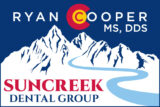
Our Services
Bruxism Treatment in Littleton
Bruxism refers to an oral parafunctional activity that occurs in most humans at some point in their lives. Grinding of the teeth and clenching of the jaw are the two main characteristics of this condition, which can occur during the day or at night.
Bruxism is one of the most common known sleep disorders and causes most of its damage during sleeping hours. The clenching and grinding which accompanies bruxism are symptomatic of a malfunctioning chewing reflex, which is turned off in non-sufferers when sleeping. For sufferers, deep sleep or even naps cause the reflex nerve control center in the brain to turn off and the reflex pathways to become active.
Typically, the incisors and canines (front 6 upper and lower teeth) of opposing arches grind against each other laterally. This side-to-side action puts undue strain on the medial pterygoid muscles and the temporomandibular joints. Earache, depression, headaches, eating disorders, and anxiety are among the most common symptoms of bruxism; these symptoms also accompany health issues such as chronic stress, Alzheimer’s disease, and alcohol abuse.
Bruxism is frequently misdiagnosed or not diagnosed at all, because it is only one of several potential causes of tooth wear. Only a trained professional can tell the difference between bruxing wear and wear caused by overly aggressive brushing, acidic soft drinks, and abrasive foods.
A BiteStrip® is an economical device used to diagnose bruxism at home. The device itself is a small electromyography that senses and monitors any activity in the jaw muscles during sleep. The frequency and severity of the condition can then be assessed and the best treatment plan can be formulated.
What Are Some Common Signs of Bruxism?
If you have bruxism, you may not realize it unless a sleep partner hears your teeth grinding and tells you about it. However, there are several other subtle symptoms that can suggest that you have bruxism.
The following are some common signs of bruxism to look out for and discuss with your dentist:
- Dull headache that often starts in your temples, especially when you wake up
- Chipped, loose, or fractured teeth
- Sore or tight jaw
- Tooth pain or sensitivity
- Damage from chewing the inside of your cheek
- Pain in your neck, face, or ear
- Popping or clicking in the temporomandibular joint (TMJ)
Why Treat Bruxism?
Here are some of the main reasons why bruxism should be promptly treated:
- Gum Recession and Tooth Loss – Bruxism is one of the leading causes of gum recession and tooth loss. It damages the soft tissue directly and leads to loose teeth and deep pockets, where bacteria can colonize and destroy the supporting bone.
- Occlusal Trauma – The abnormal wear patterns on the occlusal (chewing) surfaces can lead to fractures in the teeth, which may require restorative treatment.
- Arthritis – In severe and chronic cases, bruxing can eventually lead to painful arthritis in the temporomandibular (TMJ) joints (the joints that allow the jaw to open smoothly).
- Myofascial Pain – The grinding associated with bruxism can eventually shorten and blunt the teeth. This can lead to debilitating headaches and muscle pain in the myofascial region.
Recommended Treatments for Bruxism
There is no single cure for bruxism, though a variety of helpful devices and tools are available. Here are some common ways in which bruxism is treated:
- Mouthguards – An acrylic mouthguard can be designed from tooth impressions to minimize the abrasive action of tooth surfaces during normal sleep. Mouthguards should be worn on a long-term basis to help to stabilize the occlusion as well as prevent damage to teeth and to the temporomandibular joint.
- NTI-tss Device – This device is fitted by a health professional and only covers the front teeth. The goal of the NTI-tss is to prevent the grinding of the rear molars by limiting the contraction of the temporalis muscle.
What Are Some Alternative Treatment Strategies?
While a nightguard is a common treatment for bruxism, it isn’t the only one. The following are some alternative treatments that can sometimes be in place of or alongside a nightguard:
- Stress management – including counseling, yoga, meditation, and making time for self-care
- Lifestyle modifications – like avoiding caffeine, alcohol, and smoking, which can increase your chances of developing bruxism
- Oral exercises – that help you practice the best position for your tongue, teeth, and lips
- Biofeedback – which uses an electronic instrument to measure the muscle activity in your mouth and jaw, signaling you to indicate potentially harmful motions
- Medications – such as a muscle relaxant (for a short period of time) or anti-anxiety medication
Don’t Wait to Treat Bruxism
Bruxism is a common issue with a variety of effective treatment strategies. However, if not addressed promptly, this condition can lead to significant dental health issues. By visiting your dentist for routine check-ups and paying close attention to potential symptoms, you can help detect and treat the problem before it causes any lasting damage. If you think you may be grinding your teeth, don’t wait to reach out to your dentist.
